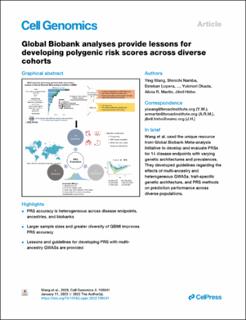| dc.contributor.author | Wang, Ying | |
| dc.contributor.author | Lopera, Esteban | |
| dc.contributor.author | Namba, Shinichi | |
| dc.contributor.author | Kerminen, Sini | |
| dc.contributor.author | Tsuo, Kristin | |
| dc.contributor.author | Läll, Kristi | |
| dc.contributor.author | Kanai, Masahiro | |
| dc.contributor.author | Zhou, Wei | |
| dc.contributor.author | Wu, Kuan-Han | |
| dc.contributor.author | Favé, Marie-Julie | |
| dc.contributor.author | Bhatta, Laxmi | |
| dc.contributor.author | Awadalla, Philip | |
| dc.contributor.author | Brumpton, Ben Michael | |
| dc.contributor.author | Deelen, Patrick | |
| dc.contributor.author | Hveem, Kristian | |
| dc.contributor.author | Faro, Valeria Lo | |
| dc.contributor.author | Mägi, Reedik | |
| dc.contributor.author | Murakami, Yoshinori | |
| dc.contributor.author | Sanna, Serena | |
| dc.contributor.author | Smoller, Jordan W. | |
| dc.contributor.author | Uzunovic, Jasmina | |
| dc.contributor.author | Wolford, Brooke N. | |
| dc.contributor.author | GBMI, . | |
| dc.contributor.author | Willer, Cristen | |
| dc.contributor.author | Gamazon, Eric R. | |
| dc.contributor.author | Cox, Nancy J. | |
| dc.contributor.author | Surakka, Ida | |
| dc.contributor.author | Okada, Yukinori | |
| dc.contributor.author | Martin, Alicia R. | |
| dc.contributor.author | Hirbo, Jibril B. | |
| dc.date.accessioned | 2023-10-23T14:29:39Z | |
| dc.date.available | 2023-10-23T14:29:39Z | |
| dc.date.created | 2023-01-26T11:03:45Z | |
| dc.date.issued | 2023 | |
| dc.identifier.uri | https://hdl.handle.net/11250/3098189 | |
| dc.description.abstract | Polygenic risk scores (PRSs) have been widely explored in precision medicine. However, few studies have thoroughly investigated their best practices in global populations across different diseases. We here utilized data from Global Biobank Meta-analysis Initiative (GBMI) to explore methodological considerations and PRS performance in 9 different biobanks for 14 disease endpoints. Specifically, we constructed PRSs using pruning and thresholding (P + T) and PRS-continuous shrinkage (CS). For both methods, using a European-based linkage disequilibrium (LD) reference panel resulted in comparable or higher prediction accuracy compared with several other non-European-based panels. PRS-CS overall outperformed the classic P + T method, especially for endpoints with higher SNP-based heritability. Notably, prediction accuracy is heterogeneous across endpoints, biobanks, and ancestries, especially for asthma, which has known variation in disease prevalence across populations. Overall, we provide lessons for PRS construction, evaluation, and interpretation using GBMI resources and highlight the importance of best practices for PRS in the biobank-scale genomics era. | en_US |
| dc.language.iso | eng | en_US |
| dc.publisher | Elsevier | en_US |
| dc.relation.uri | https://www.cell.com/cell-genomics/fulltext/S2666-979X(22)00204-X | |
| dc.rights | Attribution-NonCommercial-NoDerivatives 4.0 Internasjonal | * |
| dc.rights.uri | http://creativecommons.org/licenses/by-nc-nd/4.0/deed.no | * |
| dc.title | Global Biobank analyses provide lessons for developing polygenic risk scores across diverse cohorts | en_US |
| dc.title.alternative | Global Biobank analyses provide lessons for developing polygenic risk scores across diverse cohorts | en_US |
| dc.type | Peer reviewed | en_US |
| dc.type | Journal article | en_US |
| dc.description.version | publishedVersion | en_US |
| dc.source.volume | 3 | en_US |
| dc.source.journal | Cell Genomics | en_US |
| dc.source.issue | 1 | en_US |
| dc.identifier.doi | 10.1016/j.xgen.2022.100241 | |
| dc.identifier.cristin | 2115457 | |
| dc.relation.project | Stiftelsen Kristian Gerhard Jebsen: SKGJ-MED-015 | en_US |
| cristin.ispublished | true | |
| cristin.fulltext | original | |
| cristin.qualitycode | 1 | |

